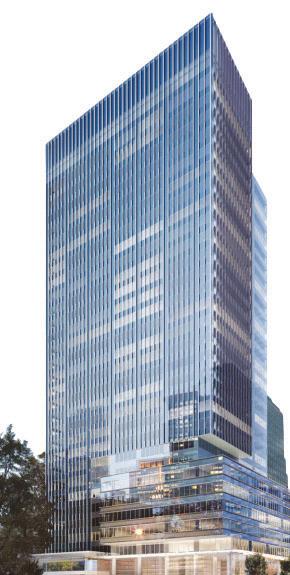
12 minute read
REAL ESTATE
08REAL ESTATE
DID YOU KNOW? REITs encounter risk when interest rates increase, leading to decreased demand for REITs. If interest rates are rising, investors generally will select safe-haven options like treasuries as they are government-guaranteed with most paying a fixed return. Consequently, when rates rise, REITs will be sold off and the bond market rallies as investment capital funds flow into bonds.
INTRODUCTION
A Real Estate Investment Trust (or REIT) is a trust that holds olds and manages real estate portfolios with pooled funds from om investors. REITs construct property portfolios, and earn income on asset holdings through leasing, capex and development opportunities. REITs offer investors a way to to access investments in large commercial/property investment opportunities which they would otherwise not be ot be able to access due to sheer scale required for such investments. Typically, REITs tend to be more value than n growth-oriented, as growth in the value of a REIT is tied to to the underlying growth in the value of the property portfolio olio that the trust holds. REITs have an ability to pass taxdeferred income to investors: if all the trust’s income for the the year is distributed to investors, the trust itself does not pay ay tax, so REITs will generally distribute all of their income to to investors each year.



Within the REITs sector, there are specialist sub sector REITs REITs which construct portfolios of real estate in particular industries, including commercial, retail and residential.

Commercial REITs
Introduction
Commercial REITs can be further categorised into office and hotel REITs. These investment trusts invest specifically into office buildings, hotel or resort properties to earn rental income and other management fees from tenants that usually have signed long-term leases.

Drivers
1.Employment and Job Market- The better the economy is performing, the better commercial REITs will perform as there will be increased consumer confidence and investor certainty in the commercial property market. This is a significant impact on the commercial REITs as an increase in job opportunities and therefore employees, will lead to increased demand for and th office spaces. office 2. 2.Vacancy ratesVacan the number of individuals uptaking rental space. This is a major risk or opportunity for investors where space few vacancies can lead to business bankruptcies. Vacancy few v rates will impact rental demand and the rent that landlords can rates charge. Where vacancy is low, rent is high and conversely charg where vacancy is high, rent is lower. where 3. 3.Location and Grade Quality- the economic performance ofLocat the area in which the commercial REIT is located is extremely the ar important. For example, investors desiring higher returns on impor investments may not consider rural locations as the rate of invest growth is considerably slower. Another consideration to the growt quality of the REITs is the property facilities available, proximity qualit to transport and CBD locations. to tran 4. 4.Supply and Construction- when new construction ofSupp commercial property occurs, this increases the supply of comm buildings leading to an overall decrease in value of property, buildi assuming demand remains the same. If supply and assum construction of commercial exceeds the demand, there will be const a general negative impact on the value of commercial REITs. a gen



Economic risk
Office and hotel REITs are typically structural investments with tenants signing leases of 5-10 years. Income for these commercial spaces are generally predictable for these years. For many companies, office space is a necessary expense, so even during economic troughs office rent will be the last to be cut. There is however still a degree of cyclicality for commercial REITs. The demand for office space and therefore landlords’ pricing power is still largely dependent on employment growth and the economic health. The economic sensitivity of office real estate companies will also depend on the structure of the tenant base. Office REITs with tenants generally operating in cyclical industries tend to be more sensitive to recessions than office REITs with the majority of tenants operating in recession-resistant businesses.




Oversupply risk
In commercial real estate, there tends to be a general trend of oversupply risk and this is especially during periods of strong economic growth and low borrowing costs. For example, if there is demand for 1,000 square feet of office space in a given market and there is exactly 1,000 square feet of inventory, properties should be full and landlords will have pricing power. Conversely, if there is 1,000 square feet of office space demanded and due to local property developments, supply increases to 2,000 square feet, there will be widespread unoccupied spaces. Despite this, oversupply is generally less concerning for commercial REIT due to high construction costs.
Structural Risks
Tech-related Risk
As workplaces become increasingly reliant on technology, the opportunities that technology has brought to organisations and individuals has undoubtedly increased. This has led to the phenomenon of remote work across all industries leading to the reduced demand for office spaces and buildings. Vacancy rates have increased from 3.9% to 5.6% across Sydney offices during the COVID-19 pandemic. This has demonstrated to many workplaces how technology can positively impact the lives of employees (allowing them to work from home), but with the commercial property consideration, has left offices empty for months.


Revolutionising Risk
Flexible workspaces, services and technologies have changed the way traditional offices operate. Modern commercial real estate companies like WeWork have revolutionised work today. This is where real estate spaces are transformed into smaller co-working spaces and areas that are more innovative and distinctive. These new, collaborative spaces have reduced the need for companies to obtain larger office spaces and rather resort to coworking spaces, a more cost-effective and flexible option. This structural change will again impact commercial REITs in the long-term.
Retail REITs



Drivers




1.Consumer sentiment index - consumer sentiment impacts retail sales and thus retail demand. This trend is thus responsible for generating demand for retail operators, and consequently boosting demand for retail property. 2.Business confidence index - affects businesses’ decisions to invest in different locations or expand in pre-existing operations. High business for retail space, with the inverse occurring as a result of reduced business confidence. 3.Demand from retail trade - retail sales drive demand for property space, as sales volumes impact retailer’s capacity to pay more expensive rents. Inversely, diminished sales volumes cause retailers to seek cheaper retail properties, thus affecting occupancy rates and property income.
Introduction
Retail is a category within the commercial REIT sector - it refers to establishments that build and develop shopping and entertainment properties. Approximately 24% of REIT investments are in shopping malls and confidence results in an increased tenant demand
freestanding retail.
The retail sector provides services that include renting, leasing, managing, developing, buying and selling retail real estate. The industry has experienced strong growth in Australia, due to increased demand from overseas investors which has boosted property value.

However, significant challenges exist within the industry - most notably the digitalisation of shopping. Retail real estate owners have nevertheless attempted to adapt, increasing a focus on occupying properties with stores that have an omnichannel strategy to drive sales in brick-and-mortar locations as well as online referred to as “click-and-mortar” stores.
Risks
Demand from online shopping -
Increasingly strong competition for traditional bricks-and-mortar retailers. Increased online sales reduces demand for physical retail space, resulting in downsizing and closure of stores. The projected strong increase of online shopping threatens industry demand.


Consumer spending and economic downturn -
Retail sales are extremely vulnerable to fluctuations in discretionary spending. The next 2-3 years are projected to have slow wage growth and rising employment, contributing to cautious consumer sentiment that will negatively impact the industry in the mid and long-term.

Industrial REITs
Introduction
Industrial REITs own and manage properties that are used for manufacturing, storing and distributing goods. This includes factories, warehouses, mines and farms. They are often located close to transportation hubs (e.g railroads and seaports) but outside of the central business district due to requirements for large space. Industrial REITS owning strategicallylocated properties with access to transit routes are more likely to attract desirable tenants as these locations enable a more efficient supply chain for manufacturers
Risks


Economic risks -
The demand for industrial facilities, in particular, distribution centers, are largely dependent on how well the economy is performing. During recessions, a decrease in the consumer confidence can slow down purchase volumes, thereby drastically lowering the need for distribution space



Capital expenditure risks -
The profitability of industrial REITs can be affected by their capital expenditure costs as industrial REITs are responsible for all property repairs. They will have to pay for unforeseen structural problems, install new equipment/systems to retain tenants or make alterations to properties due to changes in safety regulations and compliance requirements. Capital expenditure could surpass the forecasted expenditure of industrial REITs, which contributes towards reduced property valuations and lower distributions
Drivers



1.Technology - following advancements in technology, there has been an increasing demand for industrial facilities (e.g warehouses for the storage of products) due to the growing popularity of e-commerce. This is because e-commerce requires three times more warehouse space compared to traditional retail outlets. 2. Business confidence index - forecasts the economic conditions of an industry, which helps companies decide whether to expand or scale down their operations. A high business confidence index represents a more optimistic outlook of the industry, which encourages more investment by companies to develop properties. 3.Total merchandise imports and exports merchandise trading influences the demand for industrial properties as they are required for purposes of manufacturing and distributing goods. 4.Business inventories - refers to the amount of property held in stock by a company, which influences the demand for industrial properties, as an increase in business inventories means companies require more space for storage purposes
76
REIT Ratios




These are a few ratios you can look at when analysing REITs:
Adjusted Funds from Operations -
measure of financial performance that is based on funds from operations (FFO). It takes into consideration the recurring capital expenditure costs that are required to maintain the quality of REIT properties.
NTA or NAV (Net Tangible Assets or Net Asset Value) -
NTA is calculated as the company’s total assets minus all intangible assets while NAV is calculated as the company’s total assets minus its liabilities.
Funds from Operations (FFO) determines the cash flow from business operations, which is calculated by adding depreciation and amortization to the net income and then subtracting any gains
on sales.
Capitalisation Rate rate of return on a REIT based on the property’s expected income, which is calculated by dividing the property’s net operating income by its current market value.
Case Study
Abacus Property Group (ASX:ABP) is one of the leading Australian firms in the Real Estate sector. Over the years Abacus Property Group has redefined the ways of doing business in Real Estate industry.



In 2019, ABP achieved a return on equity of 6.7%. This means that for each A$1 of shareholders’ equity, Abacus made A$0.07 in profit. In comparison against the industry average, Abacus Group’s ROE is roughly in line with the REITs industry average of 7.7%. Although slightly below industry average, it has successfully built a sustainable competitive advantage in the Real Estate industry by leveraging its impressive track record to obtain favourable supplier terms.




Furthermore, whilst Abacus does have some debt (with debt to equity ratio of 0.27), it is rather modest considering the usually high level of leverage REITS has. Indeed, the careful use of debt to boost returns is often very good for shareholders, however it may reduce the company’s ability to take advantage of future opportunities.










